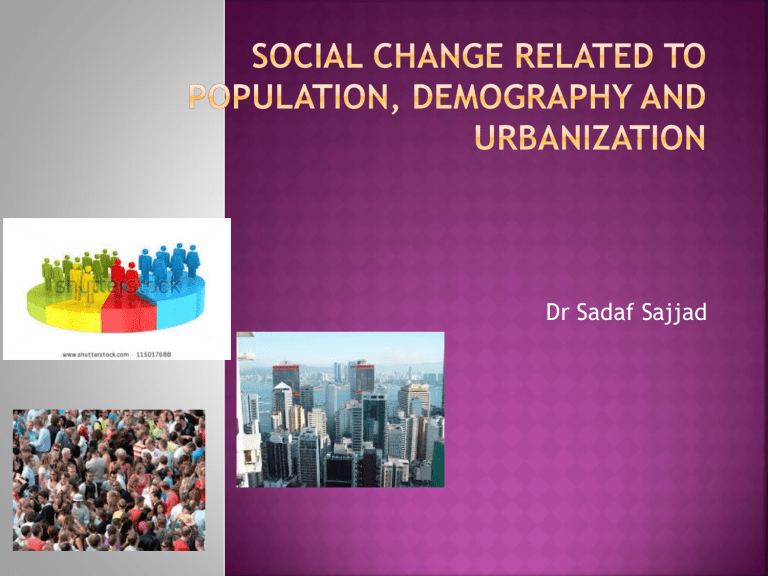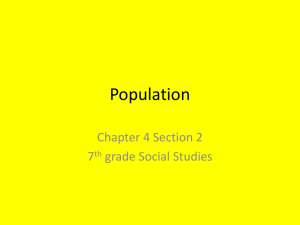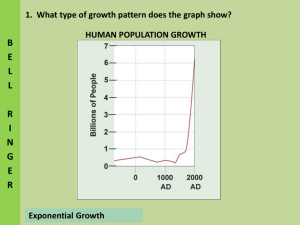Chapter 21, Population, Urbanism, And The Environment

Dr Sadaf Sajjad
A population is a summation of all the organisms of the same group, which live in the same geographical area, and have the capability of interbreeding.
Demography is the scientific study of the current state and changes over time in the size, composition, and distribution of populations.
A census is a head count of the entire population of a country, usually done at regular intervals.
Vital statistics include information about births, marriages, deaths, migrations in and out of the country, and other fundamental quantities related to population.
The number of people in a society is determined by:
Births
Deaths
Migrations
The U.S. ranks near the bottom among Western nations with a life expectancy of 76.2.
The lower one's social class, the less one's life expectancy, regardless of gender.
The gender ratio is the number of males per
100 females, or the number of males divided by the number of females, times 100.
A gender ratio above 100 means there are more males than females in the population; below 100, more females than males.
In the United States, 105 males are born for every 100 females, for a genfer ratio of 105.
After factoring in male mortality, the gender ratio is 94—there are 94 males for every 100 females.
A cohort, consists of all the persons born within a given period.
Over time, cohorts remain the same size or get smaller due to deaths, they never grow larger.
If we know of death rates for this population, we can predict the size of the cohort as it passes through the stages of life from infancy through adulthood to old age.
The idea that a population tends to grow faster than the subsistence needed to sustain it.
Malthus noted that populations grow not by arithmetic increase but by exponential increase.
The number of individuals added each year increases, with the larger population generating an even larger number of births with each passing year.
Malthus failed to foresee three revolutionary developments that derailed his cycle of growth and catastrophe.
In agriculture, technological advances
permitted farmers to work larger plots of land and grow more food per acre.
In medicine, science fought off diseases that Malthus expected to wipe out entire nations.
The development of contraceptives kept the birthrate at a level lower than
Malthus thought possible.
Proposes that countries pass through a predictable and consistent sequence of population patterns linked to the degree of technological development in the society, ending with a situation in which the birthrates and death rates are both relatively low.
The population level is predicted to eventually stabilize, with little subsequent increase or decrease over the long term.
Population change involves 3 main stages:
Stage 1 is characterized by a high birthrate and high death rate.
Stage 2 is characterized by a high birthrate but a declining death rate, increasing the overall level of the population.
Stage 3 is characterized by a low birthrate and low death rate.
The overall level of the population tends to stabilize in Stage 3.
Achievement of zero population growth solves the problem of unchecked population growth.
Zero population growth has been achieved in the United States and other countries.
Malthusian
Theory
Demographic
Transition Theory
Main Point
A population grows faster than the subsistence needed to sustain it.
Populations go through stages from high birth and death rates to a stable population with low birth and death rates.
Zero Population
Growth
Solves the Malthusian problem of unchecked population growth.
“Positive” Checks on Population Growth
Malthusian
Theory
Demographic
Transition
Theory
Zero
Population
Growth
disease, and war are likely.
disease, and war are moderately likely.
disease, and war are unlikely.
Malthusian
Theory
Prediction for the Future
Pessimistic, despite positive and preventive checks, a population will ultimately outstrip its food supply.
Demographic
Transition Theory
Optimistic, given technology and medical advances in a population.
Zero Population
Growth
Very optimistic; zero population- growth has already been achieved in the
United States and other countries.
Scholars locate the development of the first city at around 3500 B.C.
The study of the urban, the rural, and the suburban is the task of urban sociology, a subfield of sociology that examines the social structure and cultural aspects of the city in comparison to rural and suburban centers.
Urbanization is the process by which a community has the characteristics of city life and the “urban” end of the rural– urban continuum.
Simmel - urban life leads individuals to avoid emotional involvement.
Wirth - the city is a center of distant, cold interpersonal interaction.
Gans - many city residents develop strong loyalties and have a sense of community.
Any society is an ecosystem with interdependent forces:
human populations
natural resources
the environment
Wastes are dumped disproportionately frequency in areas with high concentrations of minorities.
Studies found a greater proportion of ethnic minority households closer to toxic sites even when considering households of comparable low-income status.
Women tend to be more concerned with issues of environmental risk.
Women were more likely than men to believe that abandoned waste sites cause health problems.
The U.S. census predicts that the world’s population will increase from the 6 billion it is now to 7.9 billion by the year 2020.
A few years ago, the United Nations
Division on Population estimated that the world population would stabilize as it reached 9 billion.
That estimate has been revised to 10 billion, with a high estimate of as much as
14 billion.
Sociologists predict that the United States will continue to experience increasing suburban development, with accompanying increases in heavy industry and additional pollution.
Concerns today’s sociologists have for the future:
The effect that a changing planet will have upon our lifestyle.
The effect our lifestyle will have on the planet.
Case Study: Mega Cities
Enormous cities such as,Brazil (Latin America), are considered megacities, or urban areas with a population of more than 10 million. More than 280 million people live in the world’s 25 megacities. People flock to these cities for work, but large population centers face challenges in providing transportation, energy, health care, and law enforcement.
Population Change
• Three factors affect the growth or decline of a region’s population: the birthrate, the death rate, and the rate of migration.
• In the late 1700s, Thomas Malthus predicted that populations around the world would continue to grow rapidly. His theory also stated that a rapidly growing population would outpace food production, which would cause famine.
Population Change
• Because the demographic transition theory considers a society’s level of technological development, most demographers favor that theory to the Malthusian theory.
• Many countries around the world have adopted strategies aimed at controlling their population, such as family planning and economic improvements.
Population Change
Main Idea
• The world’s population is constantly changing. Demographers study these changes and apply theories to explain them.
Reading Focus
• How do demographers study world population change?
• What theories attempt to explain population change?
• Why do some countries want to control population growth?
A Baby-less Society?
Why are the populations of some countries falling?
World Population Change
The rapid population growth of recent years has had a tremendous effect on social life.
Population: number of people living in an area at a particular time
Demography: the study of human populations
World Population Change
Death Rate
• Annual number of deaths per 1,000 members of a population
• Various kinds of death can be calculated to more accurately depict a society’s death rate.
• Infant mortality rate: number of death among infants under one year of age per 1,000
• Industrialized countries have a much lower infant mortality rate.
• Life expectancy: average number of years that a person born in a particular year can expect to live
World Population Change
Migration Rate
• Migration: the movement of people from one area to another
• Migration rate: annual number of people who move into a specified area per 1,000 members of that area’s population
• Push factors: factors that encourage people to move out of a place. Examples: persecution, famine, racial discrimination, overpopulation
• Pull factors: factors that encourage people to move into a place. Examples: religious and political freedom, economic opportunities, high standard of living
Growth Rate
• The rate at which a country’s population is increasing
• Calculated by subtracting the death rate from the birthrate and usually expressed as percentages
• U.S. rate is 0.6 percent, meaning that about 6 people were added to the population for every 1,000 members
• Growth rates in more-developed countries are typically lower.
• A population growth rate of only 1 percent will cause that population to double in size in about 70 years.
Population Composition
• The structure of a population
• Age and sex are the factors most often used to show the composition of a population.
• Population pyramid: graphic representation of the age and sex distribution of a population
• Demographers use population pyramids to help make predictions about future population needs such as health care.
Summarize
What three factors affect a region’s growth or decline in population?
Answer: birthrate, death rate, and migration rate
Urban Life
• Some sociologists study ways that the movement of populations affects the social world, especially the movement called urbanization. This movement involves the concentration of the population in cities.
• Cities first arose about 6,000 years ago on the fertile banks of major rivers in North Africa and Asia. Many of these early cities were small by modern standards and contained a few thousand people. Most preindustrial cities were very crowded and lacked any kind of sanitation system. As a result, death rates in cities were higher than those in rural areas.
Urban Life
• The industrial city was much larger than the preindustrial city, and commerce was the focal point of urban life. For the first time in history, people worked outside of the home in offices and factories. As industrial cities grew larger, crime, overcrowding and pollution increased.
Urban Life
Main Idea
Cities have evolved through time, and face many challenges today.
Reading Focus
• How did cities evolve?
• What are some of the challenges cities face today?
The Past Revisited
Do you think you could live in a city without a car?
The Evolution of the City
Urbanization is the concentration of the population into cities. A city is a permanent concentration of a relatively large number of people who are engaged mainly in nonfarming activities.
The Preindustrial City
• The first cities arose about
6,000 years ago and grew because of advances in agriculture.
• Life in early cities was crowded and dirty.
The Industrial City
• The Industrial Revolution changed life in the cities.
• Mechanization of agriculture led people to move to cities.
• Commerce and society became the focal point of life instead of the family.
Contrast
How did the industrial city differ from the preindustrial city?
Answer: The industrial city was larger in area and population. Central business districts replaced parts of the city devoted to certain trades. People worked farther away from where they lived, and the family became a less powerful force in controlling the daily life of the individual.
Urban Challenges Today
• Urbanization in more-developed countries has usually resulted in increased rates of literacy, greater economic opportunities, and improved health care.
• Urbanization in less-developed countries has been less orderly and more rapid.
• Overurbanization: a situation in which more people live in a city than can be supported in terms of jobs and facilities.
– Inadequate housing, food, sewage disposal, and hospitals
– High rates of illness and death
Draw Conclusions
How do you think overurbanization can be prevented?
Answer: Possible answer —Create more job opportunities for people in areas outside of cities so they will not be drawn into urban areas to find work or services
Cultural Diversity and Sociology
New York City’s Ethnic Neighborhoods
Centuries of migration and immigration have shaped New York
City into hundreds of distinct ethnic neighborhoods that have come to reflect the diverse cultures of these immigrants.
• Lower East Side: large population of Jews, home of the city’s first synagogue
• Chinatown: street signs in both English and Chinese, Chinese groceries and restaurants
• Jackson Heights: “Little India,” Bollywood theaters and Indian restaurants, also home to immigrants from Latin America,
Eastern Europe, and Russia
Urban Ecology
• Some sociologists developed urban ecology as an approach to studying cities. This approach examines the relationship between people and the urban environment.
• In addition to studying the structure of cities, sociologists are interested in the nature of life in cities. Several theories try to explain city life —urban anomie, compositional, and subcultural.
Urban Ecology
Main Idea
Researchers have created several models to explain the structure of cities and several theories to explain city life.
Reading Focus
• What models of city structure are there?
• How do some theories explain city life?
Models of City Structure
Urban ecology examines the relationship between people and the urban environment.
– Human behavior determines the layout of the urban environment, and in turn the urban environment affects human behavior.
– Areas of a city are created for set purposes, and as a result, people, buildings, and activities are distributed in certain patterns.
Concentric Zone Model
• A typical industrial city spreads outward from the center, resulting in a series of circles or zones.
• Each zone used differently
• Residential areas constantly changing
• Geographical features might change structure
Models of City Structure
Sector Model
• Growth occurs in wedge-shaped sectors—not concentric circles— outward from the center to the edge of the city.
• Transportation routes shape city.
Multiple Nuclei Model
• A city grows outward from several centers of activity (nuclei), not just one.
• Addresses use of automobile in cities
• Clustering occurs because it is beneficial: several stores grouped together will attract more customers than one single store.
Urban Ecology Models —A Critique
• These models describe ideal city growth conditions and are not expected to be exact reflections of any one or all urban areas.
• They account for previous trends, such as suburbanization, but not some recent trends, such as urban sprawl.
– Urban sprawl: poorly planned development on the edge of cities and towns
• Downtown residential areas are proposed to be low-income in these models, but in reality downtown areas have become high-income residential areas.
• Ignore emotional ties of a population to a particular location.
Reading Check
Summarize
What are the models of city structure?
Answer: concentric zone, sector, multiple nuclei
Theories of City Life
Urban Anomie Theory
• Anomie means “normlessness.”
• Theory proposed by Louis Wirth.
• The city is an anonymous and unfriendly place, and living there carries serious negative consequences for residents.
• Cities discourage primary group relationships. This lack of primary relationships produces anomie.
• Contact with others is short-lived, formal, and shallow.
Theories of City Life
Compositional Theory
• The composition of a city’s population influences city life.
• Age, race, ethnicity, education, income, and occupation affect urban lifestyle.
• Five identifiable lifestyles among city dwellers
Subcultural Theory
• Characteristics of the city encourages primary group relationships.
People form groups around interests.
• Because of the city’s size and diversity, people can find others who share their interests and lifestyles.
Reading Check
Explain
How does the subcultural theory describe the formation of relationships?
Answer: Since there are many people in cities who might share one’s interests, there are also more opportunities to form associations and friendships with people.
1. The study of the current state and changes over time in the size, distribution, and composition of human populations is called: a.
etiology b.
ecology c.
urban planning d.
demography
The study of the current state and changes over time in the size, distribution, and composition of human populations is called
demography.
2. The idea that a population tends to grow faster than the subsistence needed to sustain it, is referred to as: a.
human ecology b.
population bomb c.
Malthusian theory d.
demographic transition theory
The idea that a population tends to grow faster than the subsistence needed to sustain it, is referred to as Malthusian theory.
3. All of the following are what Malthus called
'positive checks" on population growth, except: a.
disease b.
birth control c.
war d.
famine
All of the following are what Malthus called
'positive checks" on population growth, except birth control.
4. Birthrate and family size are known to be related to the overall level of economic development of a country.
a. True b. False
Birthrate and family size are known to be related to the overall level of economic development of a country.







